December 16, 2013
By Trevor Jones and Katarzyna Nowak
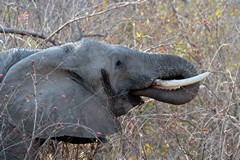
Elephants in Ruaha are being increasingly
targeted
Earlier this month, international media ran with a major prediction released by the International Union for the Conservation of Nature (IUCN) that “one-fifth of Africa’s Elephants could be wiped out in the next ten years, at current poaching levels.”
This is a damaging underestimate that undercuts the seriousness of the current disaster, and the efforts being made to turn the situation around.
Given the widespread killing of elephants for their tusks over the last five to ten years, and the paucity of accurate and up-to-date surveys of elephant populations across Africa, it is very difficult to make regional estimates of total numbers and projections for the future, let alone for the whole continent.
However, let us consider some of the solid information that has been provided recently in peer-reviewed articles and reports by in situ scientists.
Severe Declines
In Tanzania, which until recently harbored the continent’s second largest number of
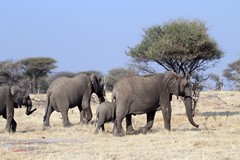
Elephant family in Ruaha
savanna elephants (after Botswana), the results of an aerial census of the Selous ecosystem carried out this October have just been announced—at the 9th Scientific Conference of the Tanzania Wildlife Research Institute (TAWIRI), held December 4-6 in Arusha.
The Selous ecosystem (31,040 square miles) is Africa’s largest protected area and holds East Africa’s greatest elephant population. In the early 1970s, it was estimated to exceed 100,000 elephants, but by the end of the last great ivory poaching crisis in the late 1980s, the number had fallen to about 20,000.
Following the global ivory trade ban enacted in 1989, the population recovered to about 55,000 elephants by 2007—when the current wave of killing escalated. By 2009, Selous elephants were down to about 39,000. The latest, recently announced population estimate is 13,084. This indicates an unprecedented decline of nearly 80 percent over the last six years.
We await with trepidation imminent results from East Africa’s second largest population, Ruaha-Rungwa (13,384 square miles), also in southern Tanzania, where large numbers of fresh carcasses are reported from Rungwa Game Reserve and parts of Ruaha National Park.
The picture is likely to be equally grim in western Tanzania (Katavi-Rukwa, Ugalla, Moyowosi-Kigosi), where demographic surveys in 2009-10 indicated poaching pressure similar to or worse than in the Selous.
In Central Africa, an extensive study bringing together survey data from 80 sites estimated a 62 percent decline in the forest elephant from 2002-2011—and these data are already two years out of date.
Southern Herds are Increasingly Vulnerable
Southern Africa has not been hit as hard as the rest of the continent—yet—but all
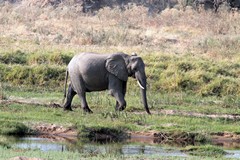
Elephant at the Ruaha River
reports indicate that the situation is worsening.
Poaching is heavy in Mozambique and is now affecting South Africa’s Kruger National Park, which is partially contiguous with Mozambique’s Limpopo National Park as part of the transboundary Peace Park.
In October, more than 300 elephants died of cyanide poisoning in Zimbabwe.
As East and Central Africa become drained of their elephants, it is reasonable to expect poaching syndicates to increasingly focus on the southern populations.
The IUCN press release came from the International Elephant Summit convened last week in Gabarone, Botswana.
What is happening in this hugely important country for elephants is not clear, but President Khama, in his welcoming address to delegates, struck a tone that was both poignant and more realistic than that of the IUCN: “Africa’s human and natural resources have been pillaged and plundered for generations by people from far off lands. From slavery to archaeological artifacts, minerals, fauna and flora, the continent and its people have for so long been victims of other continents’ selfish interests, and today it is continuing…our elephant ivory and rhino horn are going to countries where they are used for God knows what! Only to satisfy ridiculous outdated beliefs whilst we remain with carcasses, as proof we once owned these magnificent animals.”
Misleading Figures
So what was the IUCN prediction based on?
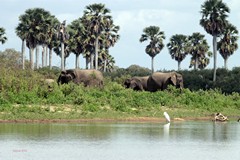
It appears to be based on a combination of analysis of carcass data from the CITES Monitoring the Illegal Killing of Elephants (MIKE) program and continent-wide population estimates as presented by IUCN’s African Elephant Specialist Group (AfESG) in the African Elephant Database (AED).
While the MIKE database aims to indicate levels of poaching at 42 sites around the continent, with the exception of a small number of well-monitored areas (notably Laikipia-Samburu in Kenya), monitoring effort and reporting levels are generally inadequate, and these data must be treated with great caution.
While the AED collates population estimates from scientific surveys, the majority of these are now significantly out of date given the current rapid rates of decline demonstrated in Selous and elsewhere.
For example, most of the estimates for Tanzania are from 2009; for Botswana, from 2006; for Zimbabwe, Gabon, and DRC, even earlier than 2006.
The reality is that this database cannot keep up with the current rates of decline.
Based on this outdated information, the AfESG and IUCN cite a figure of around 500,000 African elephants left in the wild.
We suspect that half that number is now closer to the truth.
Keeping it real
The widely reported IUCN soundbite is not only a gross underestimate of how many
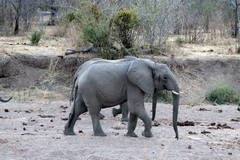
Elephants on a sand river
elephants we are likely to lose over the next ten years “if current rates of poaching persist,” but it also deflects attention from the unprecedented losses of elephants that have already occurred over the past decade.
Following the IUCN/MIKE predictive method, we ought instead to be pointing out that according to the most recent, reliable scientific estimates, many formerly great populations could be 100 percent wiped out in the next five years.
Among the locations that could so soon be devoid of elephants are: Zakouma, Chad; Yankari, Nigeria; Virunga, DRC; Caprivi, Namibia; Garamba, DRC; Queen Elizabeth, Uganda; and now, Selous-Mikumi, Tanzania.
In an age of many endangered and declining species, all rightly jostling for our concern and protection, a predicted 20 percent loss of African elephants over the next decade appears, on the surface, relatively un-concerning.
The reality is far worse, and the situation far more urgent, and misleading statements from respected conservation bodies can set back efforts to rally the priority international support and the action on the ground that are required to turn things around.
It is never easy to know how many elephants are left, nor to make predictions—and elephant protection and well-being are much more than a numbers game. Indeed, in many places where we know populations are being decimated, we cannot afford to wait for more information. We must simply act.
In modern conservation politics, however, numbers are hugely important—We hope that the recently announced pan-African aerial census scheduled for 2014 will provide a clearer picture of what we have already lost across the continent.
Most of all, we must ensure that information put into the public realm is as real as possible.
Drs. Trevor Jones and Katarzyna Nowak direct the Udzungwa Elephant Project in southern Tanzania.